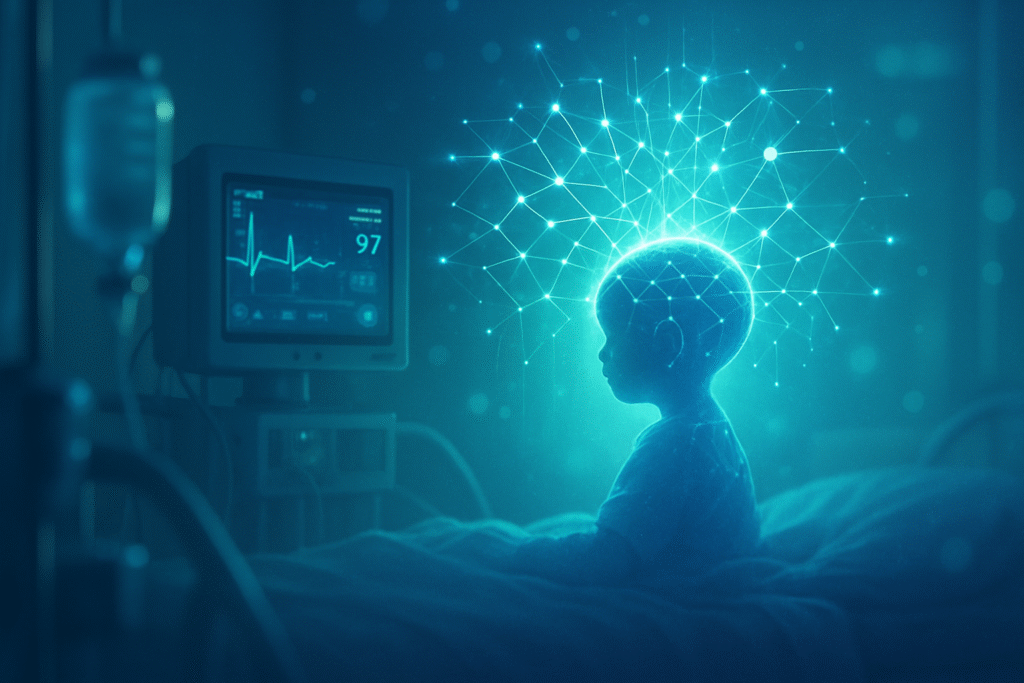
October 14, 2025 – A groundbreaking advancement in artificial intelligence is set to transform pediatric critical care, as AI models demonstrate remarkable success in predicting the onset of sepsis in children hours before clinical recognition. This medical breakthrough promises to usher in an era of truly preemptive care, offering a critical advantage in the battle against a condition that claims millions of young lives globally each year. The ability of these sophisticated algorithms to analyze complex patient data and identify subtle early warning signs represents a monumental leap forward, moving beyond traditional diagnostic limitations and offering clinicians an unprecedented tool for timely intervention.
The immediate significance of this development cannot be overstated. Sepsis, a life-threatening organ dysfunction caused by a dysregulated host response to infection, remains a leading cause of mortality and long-term morbidity in children worldwide. Traditional diagnostic methods often struggle with early detection due to the non-specific nature of symptoms in pediatric patients, leading to crucial delays in treatment. By predicting sepsis hours in advance, these AI models empower healthcare providers to initiate life-saving therapies much earlier, dramatically improving patient outcomes, reducing the incidence of organ failure, and mitigating the devastating long-term consequences often faced by survivors. This technological leap addresses a critical global health challenge, offering hope for millions of children and their families.
The Algorithmic Sentinel: Unpacking the Technical Breakthrough in Sepsis Prediction
The core of this AI advancement lies in its sophisticated ability to integrate and interpret vast, complex datasets from multiple sources, including Electronic Health Records (EHRs), real-time physiological monitoring, and clinical notes. Unlike previous approaches that often relied on simplified scoring systems or isolated biomarkers, these new AI models, primarily leveraging machine learning (ML) and deep learning algorithms, are trained to identify intricate patterns and correlations that are imperceptible to human observation or simpler rule-based systems. This comprehensive, holistic analysis provides a far more nuanced understanding of a child's evolving clinical status.
A key differentiator from previous methodologies, such as the Pediatric Logistic Organ Dysfunction (PELOD-2) score or the Systemic Inflammatory Response Syndrome (SIRS) criteria, is the AI models' superior predictive performance. Studies have demonstrated these ML-based systems can predict severe sepsis onset hours before overt clinical symptoms, with some models achieving impressive Area Under the Curve (AUC) values as high as 0.91. Notably, systems like the Targeted Real-Time Early Warning System (TREWS), developed by institutions like Johns Hopkins, have shown the capacity to identify over 80% of sepsis patients early. Furthermore, this advancement includes the creation of new, standardized, evidence-based scoring systems like the Phoenix Sepsis Score, which utilized machine learning to reanalyze data from over 3.5 million children to provide objective criteria for assessing organ failure severity. These models also address the inherent heterogeneity of sepsis presentations by identifying distinct patient subgroups, enabling more targeted predictions.
Initial reactions from the AI research community and industry experts have been overwhelmingly positive, hailing this as a significant milestone in the application of AI for critical care. Researchers emphasize the models' ability to overcome the limitations of human cognitive bias and the sheer volume of data involved in early sepsis detection. There is a strong consensus that these predictive tools will not replace clinicians but rather augment their capabilities, acting as intelligent assistants that provide crucial, timely insights. The emphasis is now shifting towards validating these models across diverse populations and integrating them seamlessly into existing clinical workflows to maximize their impact.
Reshaping the Healthcare AI Landscape: Corporate Implications and Competitive Edge
This breakthrough in pediatric sepsis prediction carries significant implications for a wide array of AI companies, tech giants, and startups operating within the healthcare technology sector. Companies specializing in AI-driven diagnostic tools, predictive analytics, and electronic health record (EHR) integration stand to benefit immensely. Major tech players like Google (NASDAQ: GOOGL), Microsoft (NASDAQ: MSFT), and Amazon (NASDAQ: AMZN), with their robust cloud infrastructure, AI research divisions, and existing partnerships in healthcare, are well-positioned to integrate these advanced predictive models into their enterprise solutions, offering them to hospitals and healthcare networks globally. Their existing data processing capabilities and AI development platforms provide a strong foundation for scaling such complex applications.
The competitive landscape for major AI labs and healthcare tech companies is poised for disruption. Startups focused on specialized medical AI, particularly those with expertise in real-time patient monitoring and clinical decision support, could see accelerated growth and increased investor interest. Companies like Epic Systems and Cerner (NASDAQ: CERN) (now Oracle Cerner), leading EHR providers, are crucial beneficiaries, as their platforms serve as the primary conduits for data collection and clinical interaction. Integrating these AI sepsis prediction models directly into EHR systems will be paramount for widespread adoption, making partnerships with such providers strategically vital. This development could disrupt existing diagnostic product markets by offering a more accurate and earlier detection method, potentially reducing reliance on less precise, traditional sepsis screening tools.
Market positioning will heavily favor companies that can demonstrate robust model performance, explainability, and seamless integration capabilities. Strategic advantages will accrue to those who can navigate the complex regulatory environment for medical devices and AI in healthcare, secure extensive clinical validation, and build trust with healthcare professionals. Furthermore, companies that can tailor these models for deployment in diverse healthcare settings, including low-resource countries where sepsis burden is highest, will gain a significant competitive edge, addressing a critical global need while expanding their market reach.
A New Frontier: Wider Significance in the AI Landscape
The development of AI models for predicting pediatric sepsis fits squarely within the broader trend of AI's increasing sophistication in real-time, life-critical applications. It signifies a maturation of AI from experimental research to practical, impactful clinical tools, highlighting the immense potential of machine learning to augment human expertise in complex, time-sensitive scenarios. This breakthrough aligns with the growing emphasis on precision medicine and preventative care, where AI acts as a powerful enabler for personalized and proactive health management. It also underscores the increasing value of large, high-quality medical datasets, as the efficacy of these models is directly tied to the breadth and depth of the data they are trained on.
The impacts of this development are far-reaching. Beyond saving lives and reducing long-term disabilities, it promises to optimize healthcare resource allocation by enabling earlier and more targeted interventions, potentially reducing the length of hospital stays and the need for intensive care. Economically, it could lead to significant cost savings for healthcare systems by preventing severe sepsis complications. However, potential concerns also accompany this advancement. These include issues of algorithmic bias, ensuring equitable performance across diverse patient populations and ethnicities, and the critical need for model explainability to foster clinician trust and accountability. There are also ethical considerations around data privacy and security, given the sensitive nature of patient health information.
Comparing this to previous AI milestones, the pediatric sepsis prediction models stand out due to their direct, immediate impact on human life and their demonstration of AI's capability to operate effectively in highly dynamic and uncertain clinical environments. While AI has made strides in image recognition for diagnostics or drug discovery, predicting an acute, rapidly progressing condition like sepsis in a vulnerable population like children represents a new level of complexity and responsibility. It parallels the significance of AI breakthroughs in areas like autonomous driving, where real-time decision-making under uncertainty is paramount, but with an even more direct and profound ethical imperative.
The Horizon of Hope: Future Developments in AI-Driven Pediatric Sepsis Care
Looking ahead, the near-term developments for AI models in pediatric sepsis prediction will focus heavily on widespread clinical validation across diverse global populations and integration into mainstream Electronic Health Record (EHR) systems. This will involve rigorous testing in various hospital settings, from large academic medical centers to community hospitals and even emergency departments in low-resource countries. Expect to see the refinement of user interfaces to ensure ease of use for clinicians and the development of standardized protocols for AI-assisted sepsis management. The goal is to move beyond proof-of-concept to robust, deployable solutions that can be seamlessly incorporated into daily clinical workflows.
On the long-term horizon, potential applications and use cases are vast. AI models could evolve to not only predict sepsis but also to suggest personalized treatment pathways based on a child's unique physiological response, predict the likelihood of specific complications, and even forecast recovery trajectories. The integration of continuous, non-invasive monitoring technologies (wearables, smart sensors) with these AI models could enable truly remote, real-time sepsis surveillance, extending preemptive care beyond the hospital walls. Furthermore, these models could be adapted to predict other acute pediatric conditions, creating a comprehensive AI-driven early warning system for a range of critical illnesses.
Significant challenges remain to be addressed. Ensuring the generalizability of these models across different healthcare systems, patient demographics, and data collection methodologies is crucial. Regulatory frameworks for AI as a medical device are still evolving and will need to provide clear guidelines for deployment and ongoing monitoring. Addressing issues of algorithmic bias and ensuring equitable access to these advanced tools for all children, regardless of socioeconomic status or geographical location, will be paramount. Finally, fostering trust among clinicians and patients through transparent, explainable AI will be key to successful adoption. Experts predict a future where AI acts as an indispensable partner in pediatric critical care, transforming reactive treatment into proactive, life-saving intervention, with continuous learning and adaptation as core tenets of these intelligent systems.
A New Chapter in Pediatric Medicine: AI's Enduring Legacy
The development of AI models capable of predicting sepsis in children marks a pivotal moment in pediatric medicine and the broader history of artificial intelligence. The key takeaway is the profound shift from reactive to preemptive care, offering the potential to save millions of young lives and drastically reduce the long-term suffering associated with this devastating condition. This advancement underscores AI's growing capacity to not just process information, but to derive actionable, life-critical insights from complex biological data, demonstrating its unparalleled power as a diagnostic and prognostic tool.
This development's significance in AI history is multi-faceted. It showcases AI's ability to tackle one of medicine's most challenging and time-sensitive problems in a vulnerable population. It further validates the immense potential of machine learning in healthcare, moving beyond theoretical applications to tangible, clinically relevant solutions. The success here sets a precedent for AI's role in early detection across a spectrum of critical illnesses, establishing a new benchmark for intelligent clinical decision support systems.
Looking ahead, the long-term impact will likely be a fundamental rethinking of how critical care is delivered, with AI serving as an ever-present, vigilant sentinel. This will lead to more personalized, efficient, and ultimately, more humane healthcare. In the coming weeks and months, the world will be watching for further clinical trial results, regulatory approvals, and the initial pilot implementations of these AI systems in healthcare institutions. The focus will be on how seamlessly these models integrate into existing workflows, their real-world impact on patient outcomes, and how healthcare providers adapt to this powerful new ally in the fight against pediatric sepsis. The era of AI-powered preemptive pediatric care has truly begun.
This content is intended for informational purposes only and represents analysis of current AI developments.
TokenRing AI delivers enterprise-grade solutions for multi-agent AI workflow orchestration, AI-powered development tools, and seamless remote collaboration platforms.
For more information, visit https://www.tokenring.ai/.






